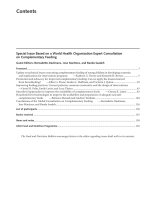EMPLOYER HEALTH COSTS DO NOT DRIVE WAGE TRENDS pot
Bạn đang xem bản rút gọn của tài liệu. Xem và tải ngay bản đầy đủ của tài liệu tại đây (145.84 KB, 5 trang )
ECONOMIC POLICY INSTITUTE • 1333 H STREET, NW
•
SUITE 300, EAST TOWER
•
WASHINGTON, DC 20005
•
202.775.8810
•
W WW.EPI.ORG
I S S U E B R I E F
E CO N O M I C P O L I C Y I N S T I T U T E
●
I S S U E B R I E F #2 69 J A N UAR Y 6, 2010
EMPLOYER HEALTH COSTS
DO NOT DRIVE WAGE TRENDS
B Y L A W R E N C E M I S H E L
F
inancing health care reform will be a prime subject of discussion among the Senate and House conferees, speci-
cally how much the nancing relies on a tax on high-cost health plans. Supporters of this tax label these “Cadil-
lac” health plans and make the assumption that they provide comprehensive (even lavish) coverage that requires
very low out-of-pocket costs from beneciaries. However, in the dysfunctional health insurance market, high-cost does
not equal high-value; and it is not comprehensiveness of coverage that is the primary predictor of who will be aected by
this tax, rather it is the size of the rm they work for or the age of their co-workers. e fact that Chevy plans are about
as likely to be taxed as Cadillac plans is one reason to be cautious about relying on such a tax. Bivens and Gould (2009)
document this as well as other reasons to prefer the more straightforward, progressive nancing in the House bill.
One claim for the Senate excise tax has recently surfaced: that health care cost increases have been a major driving
force in constraining wage growth and that wages will grow more strongly by curtailing employer health costs via the
excise tax. is claim boldly asserts that health care costs are large enough (and the tradeo with wages is large enough)
to drive major changes in overall wages. is is a much stronger claim than saying that there is some tradeo between
higher health costs and wages in the total compensation package.
1
Jonathan Gruber, an economics professor at M.I.T., argued in an op-ed in the Washington Post on December 28, 2009:
And when rms reduce their insurance generosity, they make it up in higher pay for their workers. We saw this in
the late 1990s, when the rise of managed care temporarily lowered insurance costs, and wages rose in real terms
for the rst time in many years. But as soon as managed care was weakened and health costs rose again, we once
again saw at or declining real wages in the United States. (Gruber 2009)
Others, including prominent and well-respected journalists, have also made the argument recently for a “health care
theory of wage determination.”
2
Proponents of this theory point for evidence to the latter half of the 1990s, a ve-year
period when wages were growing rapidly while growth in employer health care spending was relatively constrained. ey
contrast the period from 1995 to 2000 with the periods from 1989 to 1995 and 2000 to 2006, when wages stagnated
while health care costs grew much more rapidly.
E P I I S S U E B R I E F # 2 69
●
J A N UA R Y 6 , 2 0 1 0
●
PAG E 2
ere is logic to their argument, but it is only skin-deep and deeper examination will show it to be simply not true. e
logic can be seen looking at trends in health care premiums and wages—wage growth fared better in the late 1990s when
health care premiums grew more slowly than in the early 1990s and wages performed poorly in the 2000s, a period when
health premiums grew strongly again.
3
However, digging just a bit beneath the surface reveals the following:
1. Health care costs are not large enough to substantially move wages as these proponents claim;
2. Examination of actual wage and benet trends conrms that changes in the trajectory of health care costs did not
materially aect wage trends over the last 20 years; and
3. e wage behavior described—accelerating in the late 1990s and more slowly thereafter—actually best characterizes
wage growth for low-wage workers who have minimal access to employer-based health care. Conversely, this pattern
of wage-growth over time is least pronounced for higher paid workers with the most health coverage.
Clearly, this “health care theory of wage determination” is wrong, and other factors explain these overall wage trends.
e simple explanation is that productivity accelerated in the mid-1990s, and the low unemployment (and hikes in the
minimum wage) facilitated faster wage growth. at this wage growth disappeared entirely in the 2002-07 recovery is
not due to faster health care cost increases but to weak employment growth and employers’ ability to achieve increased
protability rather than pass on productivity gains to workers. is reveals a fundamental aw in our economy: produc-
tivity gains are not passed on to higher living standards for workers.
Scale
It is easy to understand that health care cost trends have not been a signicant driver of wage trends when one examines
the scale of employer expenditures on health care. Health care costs were just 7.6% of total compensation and 9.4% of
total wages (all wages paid, including premium pay, paid leave, and so on) in 2007.
4
e share of health care in total
wages (in nominal, non-ination adjusted terms) grew from 7.2% in 1989 to the 9.4% in 2007, suggesting that the ex-
panded role of health costs could have reduced wage growth by 2.2% over this entire 18-year period, or 0.12% each year.
is assumes a complete tradeo between health costs and wages (if every dollar of higher health costs reduced wages
correspondingly). Consequently, employer health costs can hardly be considered a major determinant of wage growth.
Further, overall benets’ (health care plus all other fringe benets) share of total compensation has actually been
stable for the last 20 years or so—as health costs expanded, pension and payroll tax shares diminished. Hence, the story
of stagnant wages in the U.S. economy is not one of growing non-wage compensation.
5
Actual wage and benefit trends
Digging deeper, consider the changes in health care costs and wages per hour worked in the early 1990s, the late 1990s,
and 2000 to 2006, the periods cited by proponents of the health care theory of wage determination.
e data in Table 1 show that wages and total compensation denitely accelerated in the late 1990s, with hourly
compensation growth tripling from a $0.22 to a $0.68 annual growth. is alone disproves the theory that moderated
health care costs were the primary driver of wages: it was not a change in the mix of compensation between wages and
benets that drove growth, rather it was the simple fact that total compensation accelerated rapidly. After 2000 compen-
sation growth subsided to $0.41per hour but still remained faster than that of the 1989-95 period.
Do trends in health care costs explain this behavior in compensation or wages? Employer health care expenditures
grew $0.03 in the late 1990s, pretty much the same as in the early 1990s, so that hardly seems an explanation. Health
care expenditures did grow more quickly in the 2000-06 period (up $0.09 each year).
is greater growth could at most explain $0.06 of the $0.45 deceleration of wage growth from 2000 to 2006 versus
the late 1990s. Interestingly, the growth of pension costs is more important than that of health costs. More important,
E P I I S S U E B R I E F # 2 69
●
J A N UA R Y 6 , 2 0 1 0
●
PAG E 3
the health care story misses and cannot explain the substantial deceleration (one-third slower) of overall compensation
growth in the 2000s.
Most economists would point to the faster productivity growth of the late 1990s to explain the faster wage and
compensation growth. In the early 1990s, as in the 1980s, productivity growth was about 1.3% each year. Productivity
growth doubled in the late 1990s to 2.5% annually and maintained that pace in the 2000s. It is the combination of this
trend—a faster growing pie—and the lower unemployment and higher minimum wages that allowed workers the lever-
age to make sure their wage growth kept pace with overall productivity.
But the lessons of the 2000s are also instructive: despite the faster productivity growth there has been no real wage
growth recently, either for those with a high school or a college degree (See Mishel et al. (2009), Figure 3A).
ere is something fundamentally broken about our economy when workers gain nothing from productivity
growth, and this should give pause to those who assume that when employers lower their health care expenses they will
automatically pass these savings onto workers in the form of higher wages. is is an especially problematic assumption
given the very high unemployment expected to prevail over the next ve years, an environment where workers will have
little leverage.
Wage trends for low-, middle-, and high-wage workers
e last piece of evidence on this issue is data on the wage trends for workers at diering wage levels. e same trends dis-
cussed above—accelerated wage growth in the late 1990s and the subsiding of this growth in the 2000s—are evident across
the board for segments of the workforce that have extensive health care coverage and those for whom coverage is sparse.
is is a point made by Jared Bernstein and Sylvia Allegretto in an analysis in 2006:
About half of all workers don’t even receive employer-provided coverage. According to the U.S. Bureau of Labor
Statistics (BLS), 47% of workers did not participate in employer-provided health care benet plans in 2005.
us, there is no health care squeeze that would explain the wage losses of nearly half the workforce. In addi-
tion, the BLS data show that among workers whose average wage was less than $15 per hour last year, only 39%
participated in employer-provided health plans… low-wage workers also lost the most ground in terms of real
wages. us, those least likely to get health care experienced the greatest loss in real wages, the opposite of what
the trade-o explanation would predict. (Bernstein and Allegretto 2006)
TABLE 1
Wage and benefit trends, 1989-2007
Inflation-adjusted (in $2007)
Wages and
salaries
All
benefits
Voluntary benefits
Total
compensationYear Pension Health*
Change in pay per hour
(1) 1989-95 $0.18 $0.04 $0.00 $0.02 $0.22
(2) 1995-00 0.66 0.02 -0.02 0.03 0.68
(3) 2000-06 0.21 0.19 0.07 0.09 0.41
(2) - (1) 0.48 -0.02 -0.02 0.01 0.46
(3) - (2) -0.45 0.17 0.09 0.06 -0.28
* Health benefits adjusted for inflation using a medical care series.
SOURCE: Mishel, Bernstein, and Shierholtz (2009), Tables 3.3 and 3.11.
E P I I S S U E B R I E F # 2 69
●
J A N UA R Y 6 , 2 0 1 0
●
PAG E 4
Table 2 shows the wage growth for workers at every decile over the 1989 to 2007 period, including the relevant
sub-periods. Wage growth was far faster from 1995 to 2000 than in the 1989-95 period at every wage level. However,
the acceleration of wage growth was far greater for low- and middle-wage workers, the groups with the least coverage
by employer-provided health care plans: only 27% and 64%, respectively, of workers in the bottom and middle fths
of the wage distribution received employer-sponsored health insurance in 2000 (see coverage by wage fth in Mishel et
al. (2009), Table 3.12). is further reinforces how health care cost containment of the late 1990s was not the major, or
even an important, determinant of wage trends. Note that the acceleration of wages for the two highest-paid groups—at
the 90th and 95th percentiles—was half that of what the lowest-paid workers enjoyed even though 80% of the highest
fth of earners received employer-sponsored health coverage. is runs directly counter to the notion that health care
costs are driving wage trends. Note also that wage growth was substantially diminished in the 2000s, even though pro-
ductivity growth continued at the same fast pace. In the recovery period from 2002 to 2007 there was hardly any wage
growth at all (see Mishel et al. (2009), Table 3.1). e worst wage growth in the 2000s was for low- and middle-wage
workers, the groups with the least health care coverage. So, it does not seem likely that faster health care premium growth
in the 2000s can explain the disappointing wage growth.
Conclusion
e recent claims that trends in employer health care expenditures explain the benecial wage growth of the late 1990s
and the disappointing wage growth since 2000 does not hold up to any careful scrutiny. Health care expenditures are
relatively small compared to overall wages, and an examination of the actual trends shows that health care cost increases
do not correspond to the major movements in wages or compensation. is is especially the case for the wage trends of
low- and middle-wage workers: their wages accelerated the most in the late 1990s and grew the least in the 2000s. e
fact that these groups have the least participation in employer-provided health plans conrms that health care is not
the major factor that the advocates of this new health care theory of wage determination would have us believe. ere
undoubtedly is a tradeo between health care costs and wage growth, but this dynamic does not play a leading role in
the drama of the stagnant wages facing workers for several decades and the inability of working families to benet from
rising productivity growth.
TABLE 2
Hourly wage growth for workers by wage level, 1989-2007
Wage by percentile*
Year 10 20 30 40 50 60 70 80 90 95
Real hourly wage
1989 $6.72 $8.37 $10.03 $11.99 $13.93 $16.27 $19.37 $23.15 $29.24 $35.94
1995 6.84 8.36 9.99 11.75 13.68 16.19 19.30 23.37 30.20 37.87
2000 7.60 9.35 10.93 12.63 14.74 17.44 20.67 25.12 32.83 41.88
2007 7.79 9.45 11.03 12.94 15.11 17.93 21.29 26.27 35.23 45.52
Percent change
1989-95 1.8% -0.1% -0.5% -2.0% -1.8% -0.5% -0.3% 0.9% 3.3% 5.4%
1995-2000 11.1 11.9 9.4 7.5 7.7 7.7 7.1 7.5 8.7 10.6
2000-07 2.5 1.0 0.9 2.4 2.6 2.9 3.0 4.6 7.3 8.7
* The Xth percentile wage is the wage at which X% of the wage earners earn less and (100-X)% earn more.
SOURCE: Mishel, Bernstein, and Shierholtz (2009), Tables 3.5.
E P I I S S U E B R I E F # 2 69
●
J A N UA R Y 6 , 2 0 1 0
●
PAG E 5
References
Bernstein, Jared, and Sylvia Allegretto. 2006. e Wage Squeeze and Higher Health Costs. EPI Issue Brief #218. Washington D.C.:
Economic Policy Institute. />Bivens, Josh, and Elise Gould. 2009. e House Health Care Bill is Right on the Money: Taxing High Incomes is Better an Taxing High Pre-
miums. EPI Issue Brief #267. Washington D.C.: Economic Policy Institute. />Gruber, Jonathan. 2009. ‘Cadillac’ tax isn’t a tax—it’s a plan to nance real health reform. Op-ed. Washington Post. December 28.
/>Mishel, Lawerence, Jared Bernstein, and Heidi Shierholtz. 2009. e State of Working America 2008/2009. Washington, D.C: Eco-
nomic Policy Institute.
Endnotes
1 I remain a skeptic that the tradeo is 100% over any short-run period, especially the high unemployment period ahead. at is a dierent
topic for another time.
2 Ezra Klein, in his (appropriately) highly regarded blog for the Washington Post and in an op-ed, was the rst to enunciate this “health care
theory of wage determination”:
From 1989 to 1995, median wages actually fell a bit. en, managed care kicked in. Annual growth in health-care costs fell from more than
10 percent in the early 1990s to less than 5 percent in the late ‘90s. Meanwhile, wages shot through the roof, rising more than 11 percent from
1995 to 2000. en we ended the managed-care experiment, and health-care costs resumed their normal speed of growth. Predictably, wages
slumped back down from 2000 to 2006. ( /> David Leonhardt, an inuential economics reporter for the New York Times, weighed on this as well:
A dollar that an employer spends on insurance is a dollar that’s unavailable for income. is helps explain why the one period of slow growth
in medical costs over the last two decades — the late 1990s — was also the one period of rapid income growth. (imes.
com/2009/12/23/business/economy/23leonhardt.html?_r=1)
3 See Exhibit One in this compilation from the Kaiser Foundation: http://www.k.org/insurance/7672/upload/7693.pdf.
4 See the Bureau of Labor Statistics’ survey of Employer Costs for Employee Compensation, Table 9, />ocwc/ect/ececqrtn.pdf.
5 See the Bureau of Labor Statistics’ survey of Employer Costs for Employee Compensation, Table 9, />ocwc/ect/ececqrtn.pdf.









